STAT6000: Interpreting Statistics in Public Health Research Articles
VerifiedAdded on 2022/09/14
|10
|2390
|17
Homework Assignment
AI Summary
This assignment involves a detailed analysis of two research articles related to public health. The first article examines alcohol and drug use at school leavers' celebrations, focusing on hypothesis testing, sampling methods, demographic characteristics, inferential statistics, and the interpretatio...
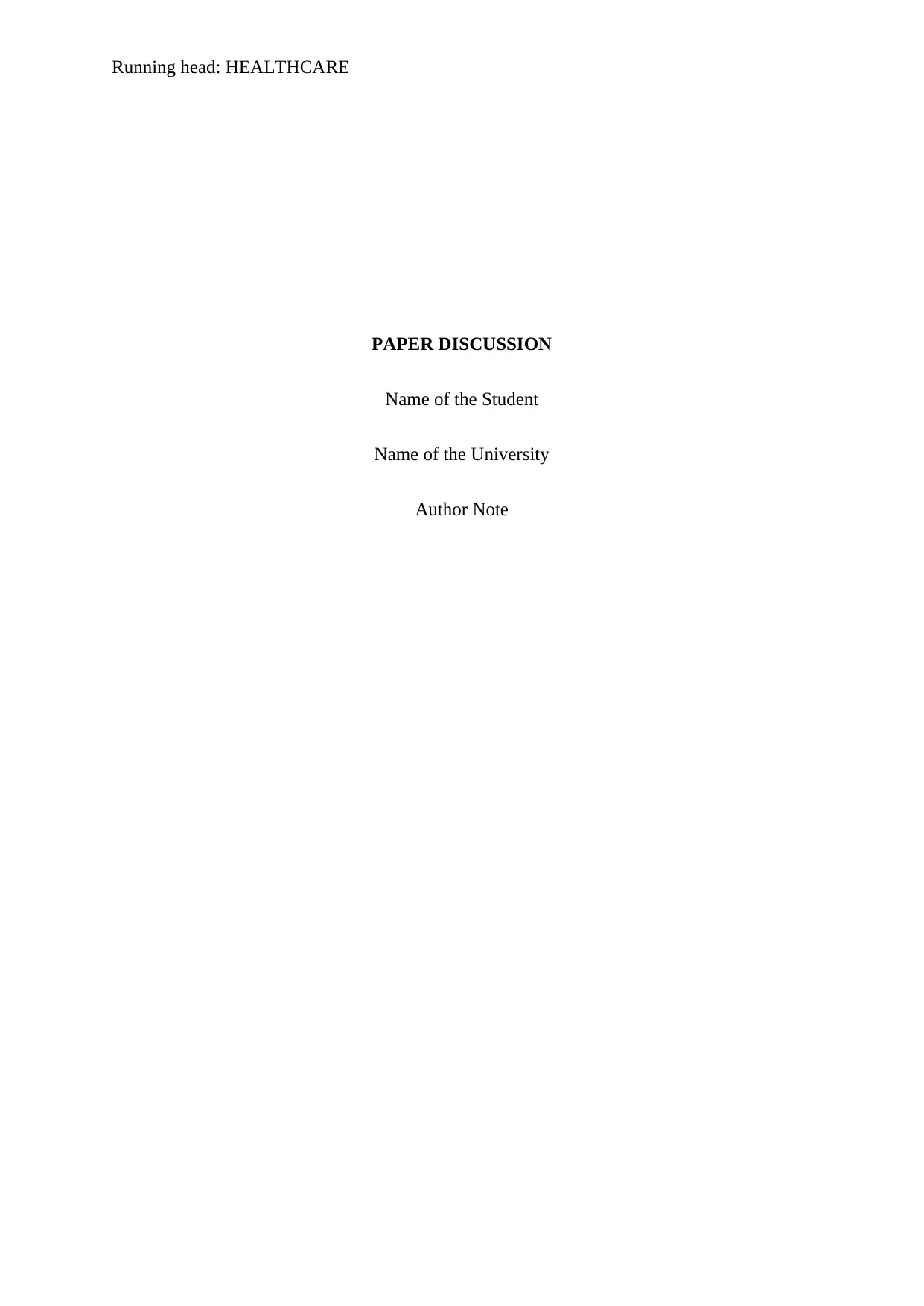
Running head: HEALTHCARE
PAPER DISCUSSION
Name of the Student
Name of the University
Author Note
PAPER DISCUSSION
Name of the Student
Name of the University
Author Note
Paraphrase This Document
Need a fresh take? Get an instant paraphrase of this document with our AI Paraphraser

1HEALTHCARE
Paper 1: Lam, T., Liang, W., Chikritzhs, T., & Allsop, S. (2014). Alcohol and other drug
use at school leavers' celebrations. Journal of Public Health, 36(3), 408-416. Retrieved
from:
http://jpubhealth.oxfordjournals.org/content/early/2013/08/26/pubmed.fdt087.full.pdf+
html
Answer 1
When there is no specific difference between the chosen populations or any observed
difference due to experimental and sampling error. Every research paper has its own null
hypothesis which is stated in the hypothesis section by the author. Hypothesis are used in
order to check the dependency of the study variable. Null hypothesis always talks of
independency of variables whereas the alternate hypothesis talks of dependency of variables.
On the other hand, it can be stated that the alternative hypothesis says that there is a statistical
relationship between the chosen variables. In every research study, either of the two studies is
accepted and one is rejected.
Null hypothesis (H0) = The levels of alcohol consumption is not dependant on difference in
occasions (school end celebration and social events).
The alternative hypothesis (H1) = The levels of alcohol consumption is dependent on the
difference in occasions (school end celebration and social events).
Independent variable (the variable which does not change with respect to the other variable)=
School end celebrations and social events
Dependant variable (the variable which changes with respect to the other variable)= Alcohol
consumption and Human health
Answer 2
Paper 1: Lam, T., Liang, W., Chikritzhs, T., & Allsop, S. (2014). Alcohol and other drug
use at school leavers' celebrations. Journal of Public Health, 36(3), 408-416. Retrieved
from:
http://jpubhealth.oxfordjournals.org/content/early/2013/08/26/pubmed.fdt087.full.pdf+
html
Answer 1
When there is no specific difference between the chosen populations or any observed
difference due to experimental and sampling error. Every research paper has its own null
hypothesis which is stated in the hypothesis section by the author. Hypothesis are used in
order to check the dependency of the study variable. Null hypothesis always talks of
independency of variables whereas the alternate hypothesis talks of dependency of variables.
On the other hand, it can be stated that the alternative hypothesis says that there is a statistical
relationship between the chosen variables. In every research study, either of the two studies is
accepted and one is rejected.
Null hypothesis (H0) = The levels of alcohol consumption is not dependant on difference in
occasions (school end celebration and social events).
The alternative hypothesis (H1) = The levels of alcohol consumption is dependent on the
difference in occasions (school end celebration and social events).
Independent variable (the variable which does not change with respect to the other variable)=
School end celebrations and social events
Dependant variable (the variable which changes with respect to the other variable)= Alcohol
consumption and Human health
Answer 2

2HEALTHCARE
They used a probability-based sampling method by using surveys for the first and second
survey processes. This factor is evident from the fact that the first survey considered young
people who intended to attend the survey and the second survey was done on the same group
of participants. Survey based sampling methods mostly use probability based method for the
collection of data from the samples. The main advantage of survey-based sampling method is
that it has a significant capability to represent a large population and data gathering process is
also convenient. The main disadvantage of survey-based sampling is that it cannot be
changed throughout the experimental process of data gathering even when it needs to be
changed for exceptions. Sometimes, survey questions are also inappropriate which reduces
the statistical significance of the survey sampling and increases bias in the process.
Answer 3
Demographic characteristics have been found to be used in the various survey-based research
studies and have been used in this paper also. In general, demographic characteristics have
been found to include qualities such as sex, age, education level, occupation and race.
However, in every research study, all the demographic characteristics are not included in the
list of questions used in the survey analysis. Age and gender were the two most significant
demographic characteristics considered for the research study. Thus only two demographic
characteristics were selected for the survey process used in this research study. For both male
and female participants, these two criteria have been considered as the demographic
characteristics of the participants. The female participants chosen for the first survey were (n
¼ 541; 56% female; 91% 17 years and 9% 18 years of age; 87%). Similar demographic
characteristics have been found to be used for the post-survey celebration also.
Answer 4
They used a probability-based sampling method by using surveys for the first and second
survey processes. This factor is evident from the fact that the first survey considered young
people who intended to attend the survey and the second survey was done on the same group
of participants. Survey based sampling methods mostly use probability based method for the
collection of data from the samples. The main advantage of survey-based sampling method is
that it has a significant capability to represent a large population and data gathering process is
also convenient. The main disadvantage of survey-based sampling is that it cannot be
changed throughout the experimental process of data gathering even when it needs to be
changed for exceptions. Sometimes, survey questions are also inappropriate which reduces
the statistical significance of the survey sampling and increases bias in the process.
Answer 3
Demographic characteristics have been found to be used in the various survey-based research
studies and have been used in this paper also. In general, demographic characteristics have
been found to include qualities such as sex, age, education level, occupation and race.
However, in every research study, all the demographic characteristics are not included in the
list of questions used in the survey analysis. Age and gender were the two most significant
demographic characteristics considered for the research study. Thus only two demographic
characteristics were selected for the survey process used in this research study. For both male
and female participants, these two criteria have been considered as the demographic
characteristics of the participants. The female participants chosen for the first survey were (n
¼ 541; 56% female; 91% 17 years and 9% 18 years of age; 87%). Similar demographic
characteristics have been found to be used for the post-survey celebration also.
Answer 4
⊘ This is a preview!⊘
Do you want full access?
Subscribe today to unlock all pages.

Trusted by 1+ million students worldwide
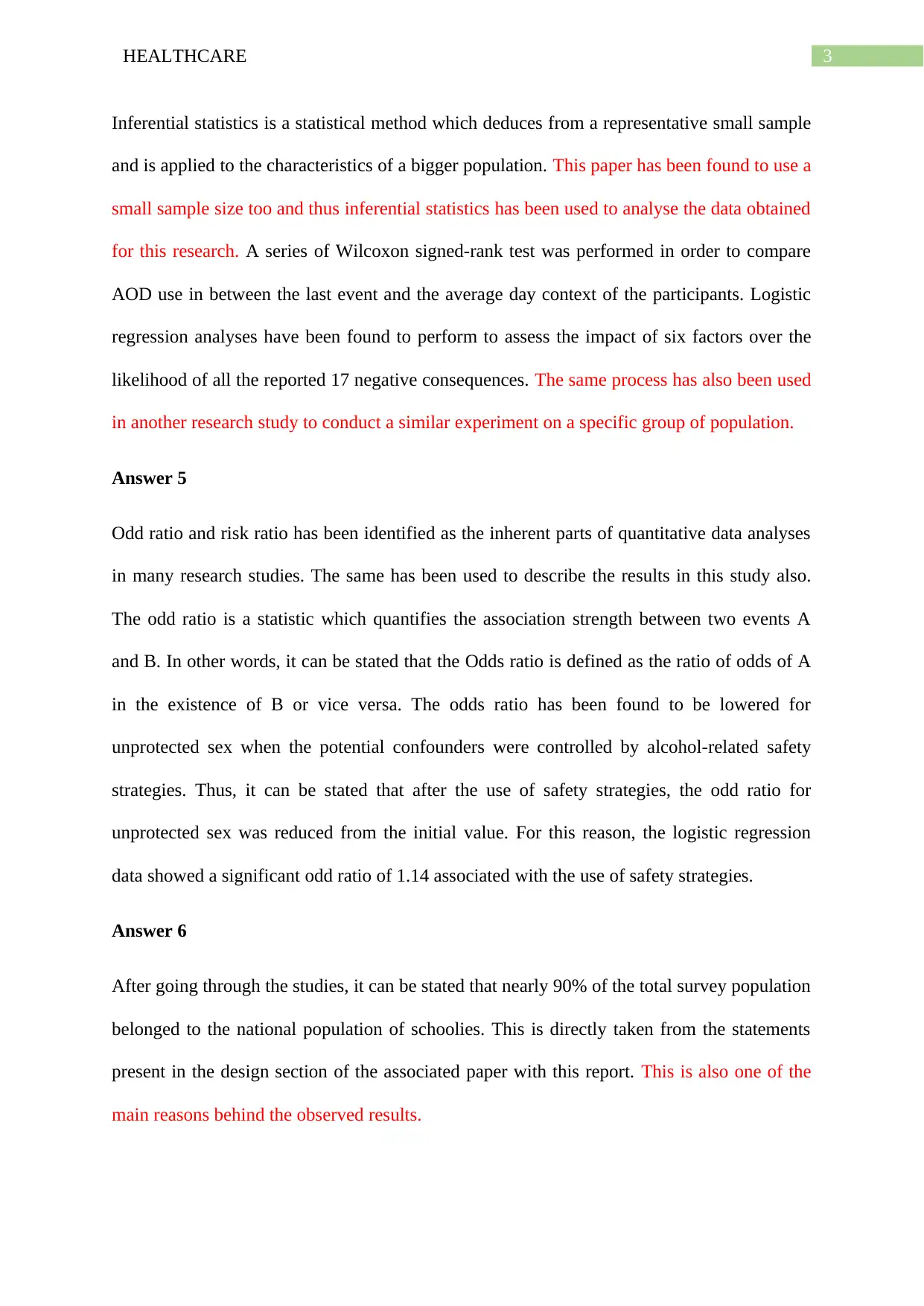
3HEALTHCARE
Inferential statistics is a statistical method which deduces from a representative small sample
and is applied to the characteristics of a bigger population. This paper has been found to use a
small sample size too and thus inferential statistics has been used to analyse the data obtained
for this research. A series of Wilcoxon signed-rank test was performed in order to compare
AOD use in between the last event and the average day context of the participants. Logistic
regression analyses have been found to perform to assess the impact of six factors over the
likelihood of all the reported 17 negative consequences. The same process has also been used
in another research study to conduct a similar experiment on a specific group of population.
Answer 5
Odd ratio and risk ratio has been identified as the inherent parts of quantitative data analyses
in many research studies. The same has been used to describe the results in this study also.
The odd ratio is a statistic which quantifies the association strength between two events A
and B. In other words, it can be stated that the Odds ratio is defined as the ratio of odds of A
in the existence of B or vice versa. The odds ratio has been found to be lowered for
unprotected sex when the potential confounders were controlled by alcohol-related safety
strategies. Thus, it can be stated that after the use of safety strategies, the odd ratio for
unprotected sex was reduced from the initial value. For this reason, the logistic regression
data showed a significant odd ratio of 1.14 associated with the use of safety strategies.
Answer 6
After going through the studies, it can be stated that nearly 90% of the total survey population
belonged to the national population of schoolies. This is directly taken from the statements
present in the design section of the associated paper with this report. This is also one of the
main reasons behind the observed results.
Inferential statistics is a statistical method which deduces from a representative small sample
and is applied to the characteristics of a bigger population. This paper has been found to use a
small sample size too and thus inferential statistics has been used to analyse the data obtained
for this research. A series of Wilcoxon signed-rank test was performed in order to compare
AOD use in between the last event and the average day context of the participants. Logistic
regression analyses have been found to perform to assess the impact of six factors over the
likelihood of all the reported 17 negative consequences. The same process has also been used
in another research study to conduct a similar experiment on a specific group of population.
Answer 5
Odd ratio and risk ratio has been identified as the inherent parts of quantitative data analyses
in many research studies. The same has been used to describe the results in this study also.
The odd ratio is a statistic which quantifies the association strength between two events A
and B. In other words, it can be stated that the Odds ratio is defined as the ratio of odds of A
in the existence of B or vice versa. The odds ratio has been found to be lowered for
unprotected sex when the potential confounders were controlled by alcohol-related safety
strategies. Thus, it can be stated that after the use of safety strategies, the odd ratio for
unprotected sex was reduced from the initial value. For this reason, the logistic regression
data showed a significant odd ratio of 1.14 associated with the use of safety strategies.
Answer 6
After going through the studies, it can be stated that nearly 90% of the total survey population
belonged to the national population of schoolies. This is directly taken from the statements
present in the design section of the associated paper with this report. This is also one of the
main reasons behind the observed results.
Paraphrase This Document
Need a fresh take? Get an instant paraphrase of this document with our AI Paraphraser
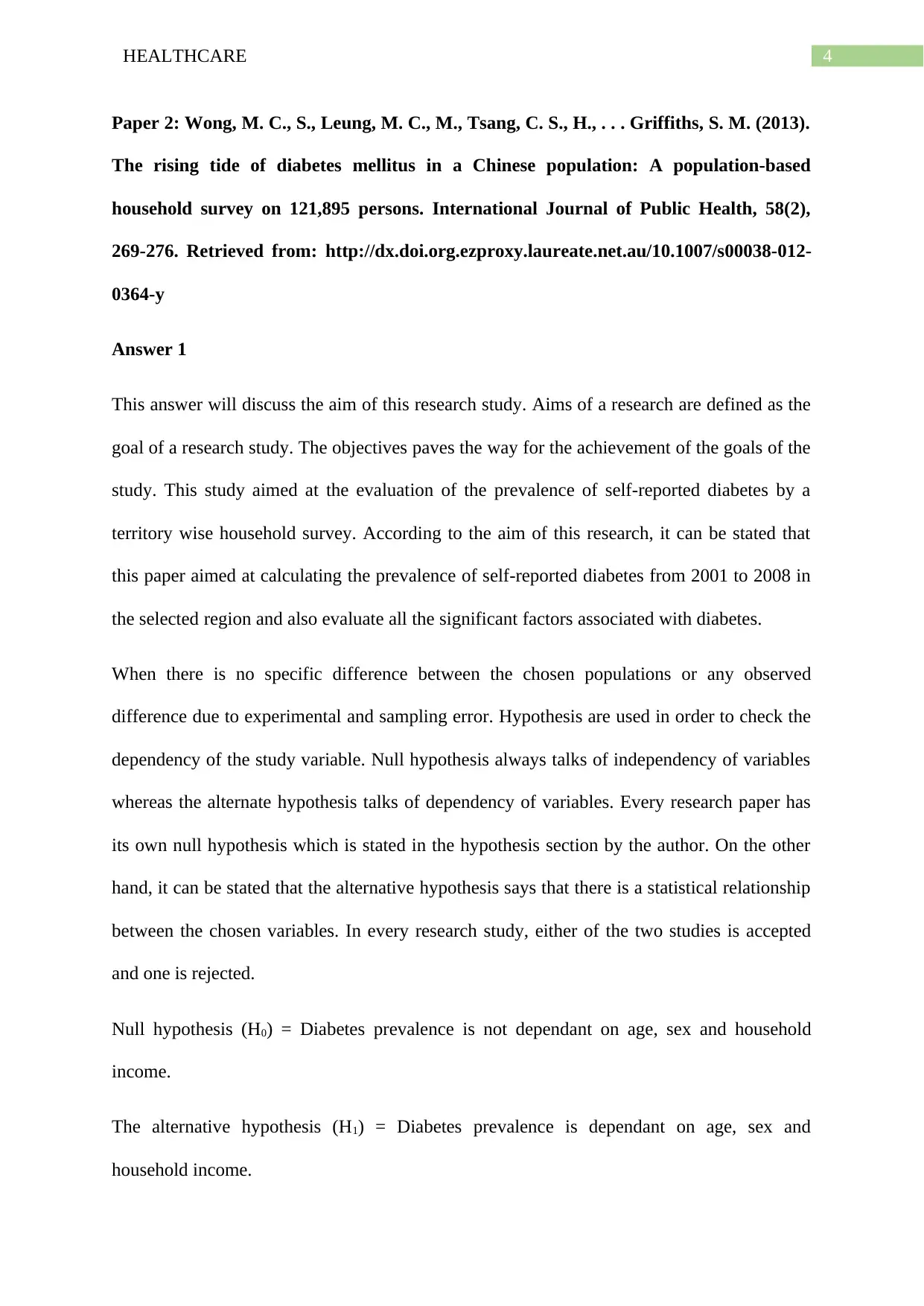
4HEALTHCARE
Paper 2: Wong, M. C., S., Leung, M. C., M., Tsang, C. S., H., . . . Griffiths, S. M. (2013).
The rising tide of diabetes mellitus in a Chinese population: A population-based
household survey on 121,895 persons. International Journal of Public Health, 58(2),
269-276. Retrieved from: http://dx.doi.org.ezproxy.laureate.net.au/10.1007/s00038-012-
0364-y
Answer 1
This answer will discuss the aim of this research study. Aims of a research are defined as the
goal of a research study. The objectives paves the way for the achievement of the goals of the
study. This study aimed at the evaluation of the prevalence of self-reported diabetes by a
territory wise household survey. According to the aim of this research, it can be stated that
this paper aimed at calculating the prevalence of self-reported diabetes from 2001 to 2008 in
the selected region and also evaluate all the significant factors associated with diabetes.
When there is no specific difference between the chosen populations or any observed
difference due to experimental and sampling error. Hypothesis are used in order to check the
dependency of the study variable. Null hypothesis always talks of independency of variables
whereas the alternate hypothesis talks of dependency of variables. Every research paper has
its own null hypothesis which is stated in the hypothesis section by the author. On the other
hand, it can be stated that the alternative hypothesis says that there is a statistical relationship
between the chosen variables. In every research study, either of the two studies is accepted
and one is rejected.
Null hypothesis (H0) = Diabetes prevalence is not dependant on age, sex and household
income.
The alternative hypothesis (H1) = Diabetes prevalence is dependant on age, sex and
household income.
Paper 2: Wong, M. C., S., Leung, M. C., M., Tsang, C. S., H., . . . Griffiths, S. M. (2013).
The rising tide of diabetes mellitus in a Chinese population: A population-based
household survey on 121,895 persons. International Journal of Public Health, 58(2),
269-276. Retrieved from: http://dx.doi.org.ezproxy.laureate.net.au/10.1007/s00038-012-
0364-y
Answer 1
This answer will discuss the aim of this research study. Aims of a research are defined as the
goal of a research study. The objectives paves the way for the achievement of the goals of the
study. This study aimed at the evaluation of the prevalence of self-reported diabetes by a
territory wise household survey. According to the aim of this research, it can be stated that
this paper aimed at calculating the prevalence of self-reported diabetes from 2001 to 2008 in
the selected region and also evaluate all the significant factors associated with diabetes.
When there is no specific difference between the chosen populations or any observed
difference due to experimental and sampling error. Hypothesis are used in order to check the
dependency of the study variable. Null hypothesis always talks of independency of variables
whereas the alternate hypothesis talks of dependency of variables. Every research paper has
its own null hypothesis which is stated in the hypothesis section by the author. On the other
hand, it can be stated that the alternative hypothesis says that there is a statistical relationship
between the chosen variables. In every research study, either of the two studies is accepted
and one is rejected.
Null hypothesis (H0) = Diabetes prevalence is not dependant on age, sex and household
income.
The alternative hypothesis (H1) = Diabetes prevalence is dependant on age, sex and
household income.

5HEALTHCARE
Answer 2
Demographic characteristics have been found to be used in the various survey-based research
studies and have been used in this paper also. In general, demographic characteristics have
been found to include qualities such as sex, age, education level, occupation and race. In this
paper, only age, sex and monthly household income have been incorporated in the
demographic characteristics for the study. The age groups selected for the study are < 15
years, 15-24 years, 25-34 years, 35-44 years, 45-54 years, 65-74 years and > 75 years. The
sex group selected for this study are male and female. The monthly household income
selected for the study includes > 50,000, 25,000-49,999, 10,000-24,999 and <9,999. Thus, it
can be stated that only three demographic characteristics were used for this research study.
These were the overall demographic characteristics selected for the study.
Answer 3
SATA version 8.0 was used for statistical analysis in this study. Inferential statistics is a
statistical method which deduces from a representative small sample and is applied to the
characteristics of a bigger population. Age and sex-adjusted prevalence rate calculations were
used for the study in order to understand the prevalence of self-reported diabetes among the
chosen population. The binary logistic regression model was used to study the prevalence of
self-reported diabetes in the Chinese population. A binary logistic regression has been used in
order to predict the odds of one being a case which is based on the values of independent
variables known as predictors. Similar regression analysis was also run in order to test the
heterogeneity in association with men and women reporting diabetes mellitus. The odds can
be defined as the probability in which a specific outcome of a case is divided by the
probability in a noncase. The P values less than equal to 0.05 was regarded to be statistically
Answer 2
Demographic characteristics have been found to be used in the various survey-based research
studies and have been used in this paper also. In general, demographic characteristics have
been found to include qualities such as sex, age, education level, occupation and race. In this
paper, only age, sex and monthly household income have been incorporated in the
demographic characteristics for the study. The age groups selected for the study are < 15
years, 15-24 years, 25-34 years, 35-44 years, 45-54 years, 65-74 years and > 75 years. The
sex group selected for this study are male and female. The monthly household income
selected for the study includes > 50,000, 25,000-49,999, 10,000-24,999 and <9,999. Thus, it
can be stated that only three demographic characteristics were used for this research study.
These were the overall demographic characteristics selected for the study.
Answer 3
SATA version 8.0 was used for statistical analysis in this study. Inferential statistics is a
statistical method which deduces from a representative small sample and is applied to the
characteristics of a bigger population. Age and sex-adjusted prevalence rate calculations were
used for the study in order to understand the prevalence of self-reported diabetes among the
chosen population. The binary logistic regression model was used to study the prevalence of
self-reported diabetes in the Chinese population. A binary logistic regression has been used in
order to predict the odds of one being a case which is based on the values of independent
variables known as predictors. Similar regression analysis was also run in order to test the
heterogeneity in association with men and women reporting diabetes mellitus. The odds can
be defined as the probability in which a specific outcome of a case is divided by the
probability in a noncase. The P values less than equal to 0.05 was regarded to be statistically
⊘ This is a preview!⊘
Do you want full access?
Subscribe today to unlock all pages.

Trusted by 1+ million students worldwide
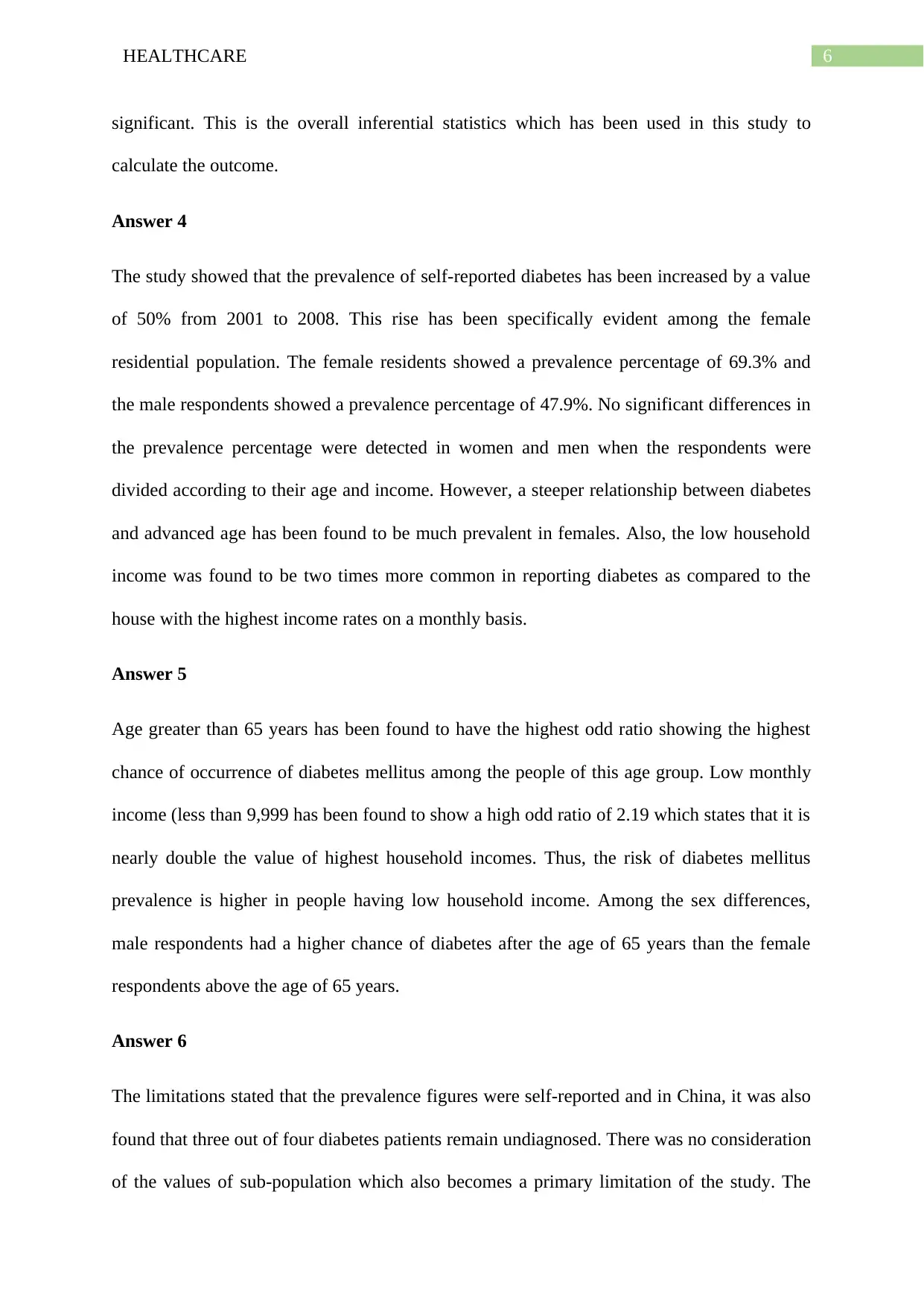
6HEALTHCARE
significant. This is the overall inferential statistics which has been used in this study to
calculate the outcome.
Answer 4
The study showed that the prevalence of self-reported diabetes has been increased by a value
of 50% from 2001 to 2008. This rise has been specifically evident among the female
residential population. The female residents showed a prevalence percentage of 69.3% and
the male respondents showed a prevalence percentage of 47.9%. No significant differences in
the prevalence percentage were detected in women and men when the respondents were
divided according to their age and income. However, a steeper relationship between diabetes
and advanced age has been found to be much prevalent in females. Also, the low household
income was found to be two times more common in reporting diabetes as compared to the
house with the highest income rates on a monthly basis.
Answer 5
Age greater than 65 years has been found to have the highest odd ratio showing the highest
chance of occurrence of diabetes mellitus among the people of this age group. Low monthly
income (less than 9,999 has been found to show a high odd ratio of 2.19 which states that it is
nearly double the value of highest household incomes. Thus, the risk of diabetes mellitus
prevalence is higher in people having low household income. Among the sex differences,
male respondents had a higher chance of diabetes after the age of 65 years than the female
respondents above the age of 65 years.
Answer 6
The limitations stated that the prevalence figures were self-reported and in China, it was also
found that three out of four diabetes patients remain undiagnosed. There was no consideration
of the values of sub-population which also becomes a primary limitation of the study. The
significant. This is the overall inferential statistics which has been used in this study to
calculate the outcome.
Answer 4
The study showed that the prevalence of self-reported diabetes has been increased by a value
of 50% from 2001 to 2008. This rise has been specifically evident among the female
residential population. The female residents showed a prevalence percentage of 69.3% and
the male respondents showed a prevalence percentage of 47.9%. No significant differences in
the prevalence percentage were detected in women and men when the respondents were
divided according to their age and income. However, a steeper relationship between diabetes
and advanced age has been found to be much prevalent in females. Also, the low household
income was found to be two times more common in reporting diabetes as compared to the
house with the highest income rates on a monthly basis.
Answer 5
Age greater than 65 years has been found to have the highest odd ratio showing the highest
chance of occurrence of diabetes mellitus among the people of this age group. Low monthly
income (less than 9,999 has been found to show a high odd ratio of 2.19 which states that it is
nearly double the value of highest household incomes. Thus, the risk of diabetes mellitus
prevalence is higher in people having low household income. Among the sex differences,
male respondents had a higher chance of diabetes after the age of 65 years than the female
respondents above the age of 65 years.
Answer 6
The limitations stated that the prevalence figures were self-reported and in China, it was also
found that three out of four diabetes patients remain undiagnosed. There was no consideration
of the values of sub-population which also becomes a primary limitation of the study. The
Paraphrase This Document
Need a fresh take? Get an instant paraphrase of this document with our AI Paraphraser
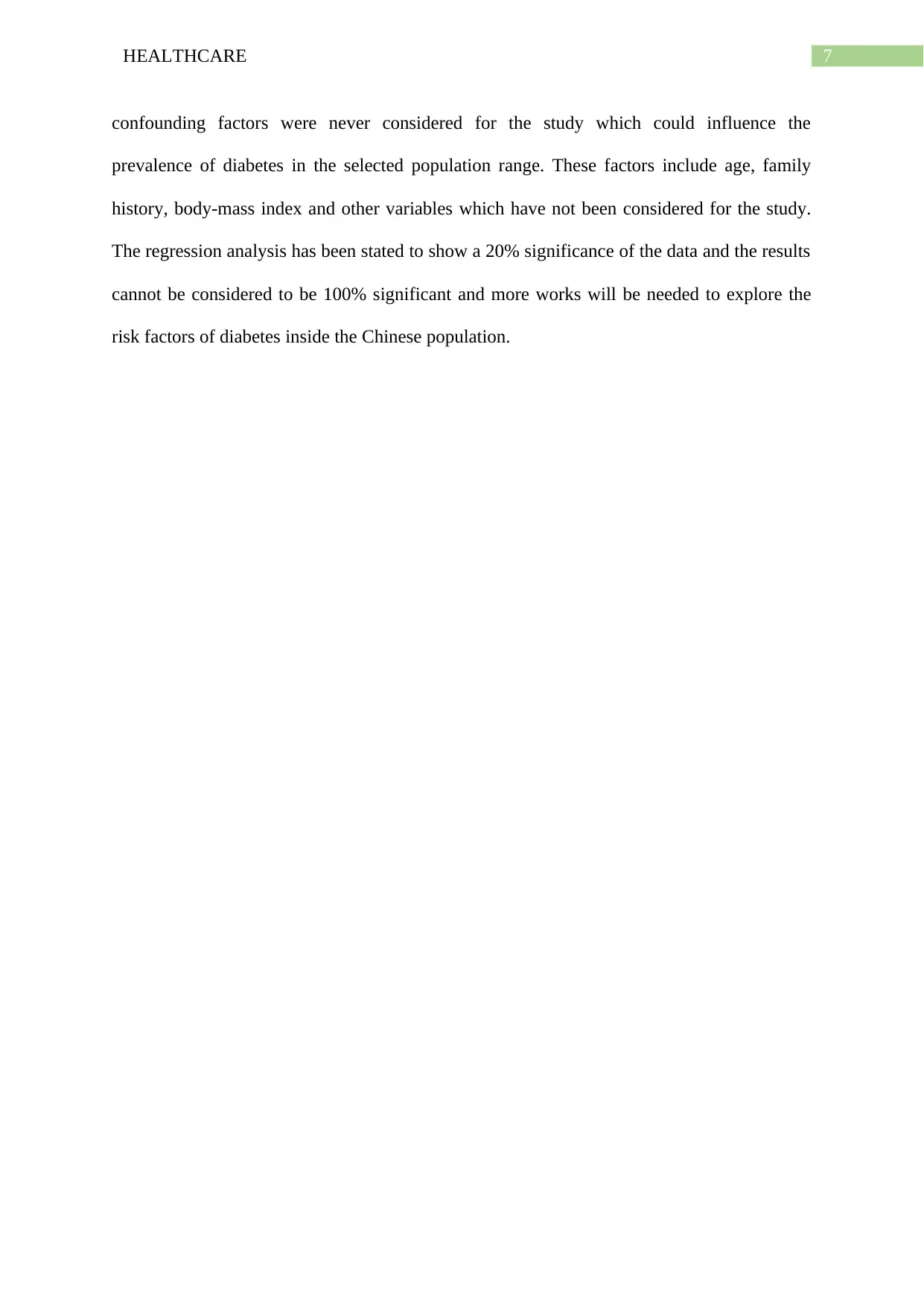
7HEALTHCARE
confounding factors were never considered for the study which could influence the
prevalence of diabetes in the selected population range. These factors include age, family
history, body-mass index and other variables which have not been considered for the study.
The regression analysis has been stated to show a 20% significance of the data and the results
cannot be considered to be 100% significant and more works will be needed to explore the
risk factors of diabetes inside the Chinese population.
confounding factors were never considered for the study which could influence the
prevalence of diabetes in the selected population range. These factors include age, family
history, body-mass index and other variables which have not been considered for the study.
The regression analysis has been stated to show a 20% significance of the data and the results
cannot be considered to be 100% significant and more works will be needed to explore the
risk factors of diabetes inside the Chinese population.
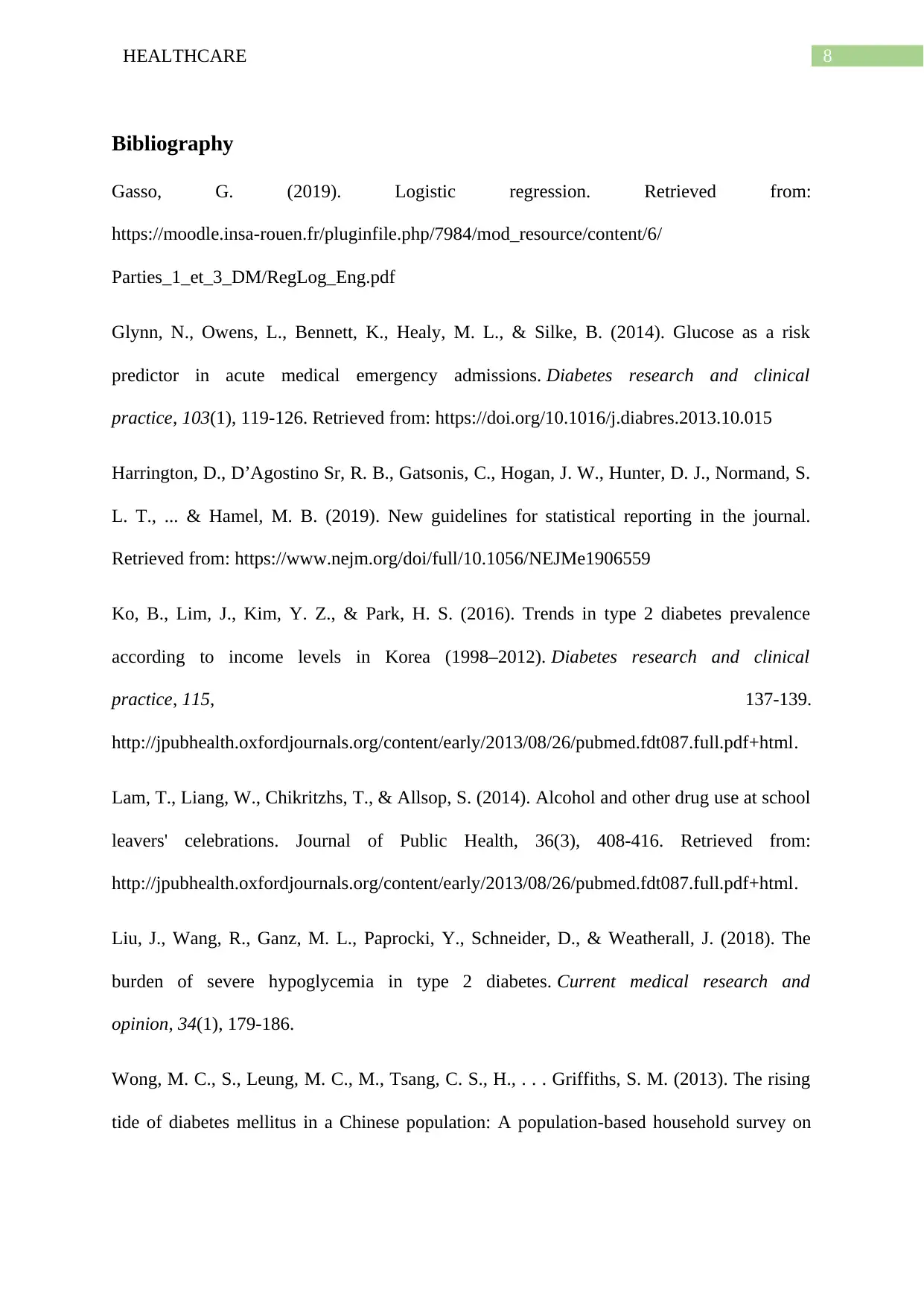
8HEALTHCARE
Bibliography
Gasso, G. (2019). Logistic regression. Retrieved from:
https://moodle.insa-rouen.fr/pluginfile.php/7984/mod_resource/content/6/
Parties_1_et_3_DM/RegLog_Eng.pdf
Glynn, N., Owens, L., Bennett, K., Healy, M. L., & Silke, B. (2014). Glucose as a risk
predictor in acute medical emergency admissions. Diabetes research and clinical
practice, 103(1), 119-126. Retrieved from: https://doi.org/10.1016/j.diabres.2013.10.015
Harrington, D., D’Agostino Sr, R. B., Gatsonis, C., Hogan, J. W., Hunter, D. J., Normand, S.
L. T., ... & Hamel, M. B. (2019). New guidelines for statistical reporting in the journal.
Retrieved from: https://www.nejm.org/doi/full/10.1056/NEJMe1906559
Ko, B., Lim, J., Kim, Y. Z., & Park, H. S. (2016). Trends in type 2 diabetes prevalence
according to income levels in Korea (1998–2012). Diabetes research and clinical
practice, 115, 137-139.
http://jpubhealth.oxfordjournals.org/content/early/2013/08/26/pubmed.fdt087.full.pdf+html.
Lam, T., Liang, W., Chikritzhs, T., & Allsop, S. (2014). Alcohol and other drug use at school
leavers' celebrations. Journal of Public Health, 36(3), 408-416. Retrieved from:
http://jpubhealth.oxfordjournals.org/content/early/2013/08/26/pubmed.fdt087.full.pdf+html.
Liu, J., Wang, R., Ganz, M. L., Paprocki, Y., Schneider, D., & Weatherall, J. (2018). The
burden of severe hypoglycemia in type 2 diabetes. Current medical research and
opinion, 34(1), 179-186.
Wong, M. C., S., Leung, M. C., M., Tsang, C. S., H., . . . Griffiths, S. M. (2013). The rising
tide of diabetes mellitus in a Chinese population: A population-based household survey on
Bibliography
Gasso, G. (2019). Logistic regression. Retrieved from:
https://moodle.insa-rouen.fr/pluginfile.php/7984/mod_resource/content/6/
Parties_1_et_3_DM/RegLog_Eng.pdf
Glynn, N., Owens, L., Bennett, K., Healy, M. L., & Silke, B. (2014). Glucose as a risk
predictor in acute medical emergency admissions. Diabetes research and clinical
practice, 103(1), 119-126. Retrieved from: https://doi.org/10.1016/j.diabres.2013.10.015
Harrington, D., D’Agostino Sr, R. B., Gatsonis, C., Hogan, J. W., Hunter, D. J., Normand, S.
L. T., ... & Hamel, M. B. (2019). New guidelines for statistical reporting in the journal.
Retrieved from: https://www.nejm.org/doi/full/10.1056/NEJMe1906559
Ko, B., Lim, J., Kim, Y. Z., & Park, H. S. (2016). Trends in type 2 diabetes prevalence
according to income levels in Korea (1998–2012). Diabetes research and clinical
practice, 115, 137-139.
http://jpubhealth.oxfordjournals.org/content/early/2013/08/26/pubmed.fdt087.full.pdf+html.
Lam, T., Liang, W., Chikritzhs, T., & Allsop, S. (2014). Alcohol and other drug use at school
leavers' celebrations. Journal of Public Health, 36(3), 408-416. Retrieved from:
http://jpubhealth.oxfordjournals.org/content/early/2013/08/26/pubmed.fdt087.full.pdf+html.
Liu, J., Wang, R., Ganz, M. L., Paprocki, Y., Schneider, D., & Weatherall, J. (2018). The
burden of severe hypoglycemia in type 2 diabetes. Current medical research and
opinion, 34(1), 179-186.
Wong, M. C., S., Leung, M. C., M., Tsang, C. S., H., . . . Griffiths, S. M. (2013). The rising
tide of diabetes mellitus in a Chinese population: A population-based household survey on
⊘ This is a preview!⊘
Do you want full access?
Subscribe today to unlock all pages.

Trusted by 1+ million students worldwide

9HEALTHCARE
121,895 persons. International Journal of Public Health, 58(2), 269-276. Retrieved from:
http://dx.doi.org.ezproxy.laureate.net.au/10.1007/s00038-012-0364-y.
121,895 persons. International Journal of Public Health, 58(2), 269-276. Retrieved from:
http://dx.doi.org.ezproxy.laureate.net.au/10.1007/s00038-012-0364-y.
1 out of 10
Related Documents
Your All-in-One AI-Powered Toolkit for Academic Success.
+13062052269
info@desklib.com
Available 24*7 on WhatsApp / Email
![[object Object]](/_next/static/media/star-bottom.7253800d.svg)
Unlock your academic potential
© 2024 | Zucol Services PVT LTD | All rights reserved.





